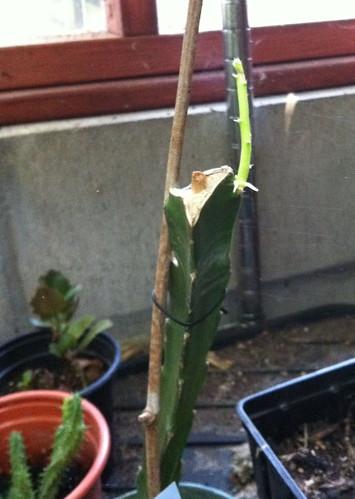The Dragonfruit plant (Hylocereus, also called Pitaya) is a climbing cactus which produces tasty horned fruits after it blooms. The plant is closely related to Epiphyllums, the orchid cacti, and the blooms look nearly identical. One of my blogging friends recently took a trip to Thailand and got to see dragonfruit growing in an orchard. These gangly plants are growing in a tangled mess on top of poles in a big field. It's crazy to see.
After I saw Derek's pictures, I decided I need to try out this plant myself. I'm not a big cactus guy, but I do like my Stapelias and I'm excited about the possibility of my Epiphyllums blooming for me one day. So I got on eBay and found an inexpensive cutting of a dragonfruit hybrid, which has red fruits - Hylocereus polyrhizus x. H. undatus. The cutting was not really rooted, but I was assured that it would be easy to root. So I stuck it in some potting soil when it arrived in the mail just two weeks ago.
I don't know what's going on underneath the soil, but up here it's doing really well, producing new growth! It must enjoy 100+ temperatures. Now I just need to decide whether I want it to climb a totem or let it dangle from the pot like most Epiphyllums are grown. It seems most people grow them climbing up a totem and then let them go crazy Medusa-like once they get to the top. I'm not sure if there is a reason for that or not. It might be close to their natural habitat, where they are most often tree-climbers. I'll have to do some more research. Interestingly enough (according to wikipedia), the native region for this plant has never been resolved.
After I saw Derek's pictures, I decided I need to try out this plant myself. I'm not a big cactus guy, but I do like my Stapelias and I'm excited about the possibility of my Epiphyllums blooming for me one day. So I got on eBay and found an inexpensive cutting of a dragonfruit hybrid, which has red fruits - Hylocereus polyrhizus x. H. undatus. The cutting was not really rooted, but I was assured that it would be easy to root. So I stuck it in some potting soil when it arrived in the mail just two weeks ago.
 |
| Hylocereus sending up a new growth |
Another way to get dragon fruit for cheap is to buy one of those grafted "moon cactus" (the ones with the orange/red/yellow top) and cut off the colorful top part. The bottom is almost always some sort of dragonfruit (not necessarily grown for the fruit though).
ReplyDeleteHi Zach & Christie,
ReplyDeleteWe grow dragonfruit in our farm here in the Philippines. Best to let your dragonfruit climb totem-type, with totem about 6 ft. tall. Once your plant has climbed to the top, it will begin to cascade, yes medusa-like. From the tips of the cascaded 'branches', the elegant flowers will grow to as big as your face. In the Philippines though, the blooms only open at night AND for just one night. Once the blooms open, you will find that the flowers are wilted by next morning. You will know that there's successful pollination when the bases of the flowers begin to swell, which eventually becomes the fruit :P
If you chose to grow dragonfruit for the fruit and wanted the red variety, you should have bought two plants. The red-type will only bear fruit when cross-pollinated. The white variety self-pollinates, so a solitary plant would do for this type.
Check out photos of dragonfruit with fruits and flowers at our website ---> [http://www.atobelensfarm.com]
Brian
Brian- Those are HUGE dragonfruits at your website. Well done! I guess I'll need to get another plant or two to be successful with the fruiting. Thanks for the advice!
ReplyDeleteWe have been practicing organic farming for years now and right at the base of the plants is a long vermi-bed. Vermicast, a.k.a. the super compost, was probably key to the big dragonfruit fruits :)
ReplyDelete